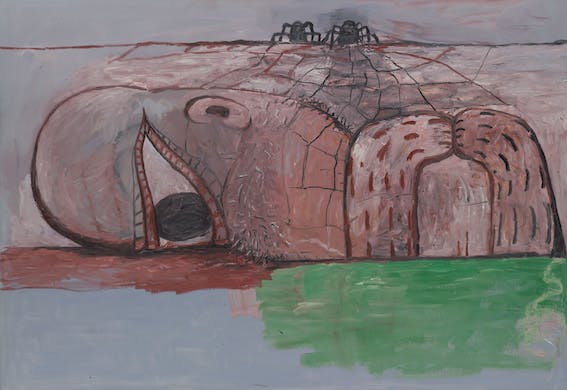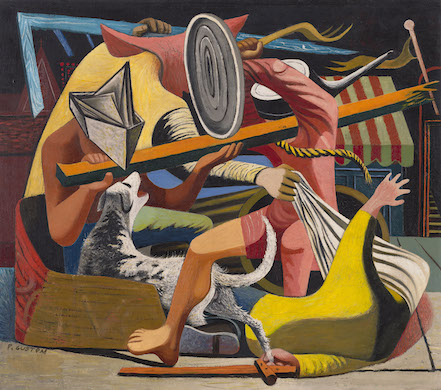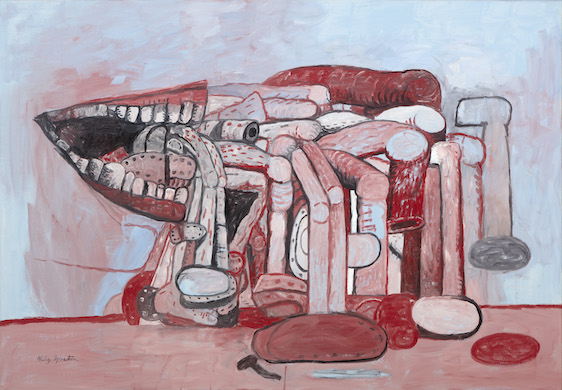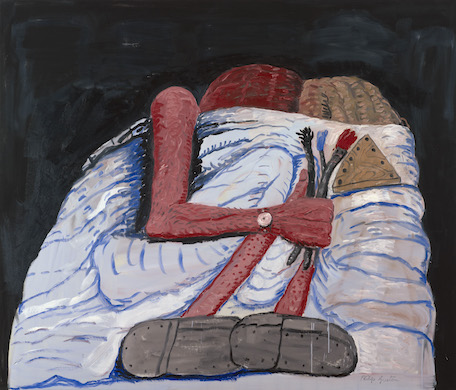Guston: A Genius Beyond Controversy
There is the option to bypass the Klan pictures altogether, via a specially designed ‘off ramp.’ Don’t take it.

Philip Guston was born Philip Goldstein, the son of refugees from Odessa, and died as one of the most original artists of the 20th century. Guston claimed that we are “image-makers and image-ridden.” To spend time with Guston’s own images is to meet an artist who in the wake of the Holocaust and in the midst of the Civil Rights movement found an artistic language for turmoil.
“Philip Guston Now,” running to September 11 at the Museum of Fine Arts in Boston, is a rightsized immersion in the work of a painter who moved fitfully between abstraction, Renaissance-esque figuration, and his signature mature style: cartoon-like large canvases that flirt with the grotesque and land just short of the straightforward. Guston is an accessible artist to look at, but a difficult one to grasp.
That difficulty was readily apparent in the kerfuffle that surrounded the show’s opening. “Now” was due to begin a four museum tour in June 2020, one that would take it from the National Gallery of Art, to the Museum of Fine Art in Houston, to London’s Tate Modern, and then finally to Boston’s MFA.
The rub is that one of Guston’s primary motifs is images of Klansmen, a reaction to the violence and unrest of the 1960s. Guston was a supporter of civil rights and equality. He called these images “self-portraits” in which he “perceived myself as being behind the hood,” an exercise in imagining evil. One well-known painting, “The Studio,” shows a hooded Klansman painting a self-portrait at an easel.
Abruptly, those institutions announced the show would be postponed to 2024, “until a time we think that the powerful message of social and racial justice that is at the centre of Philip Guston’s work can be more clearly interpreted.” They cited “the racial justice movement that started in the US” and the “urgencies of the moment” in deciding on a four-year postponement for the worldwide show.
This decision was met with a firestorm of criticism. A curator at the Tate Modern who was working on the show, Mark Godfrey, lamented that the choice was “extremely patronising to viewers.” An art critic, Jason Farago, opined that “it is bleak, beyond words, not to say cowardly, for these museums to postpone their Guston retrospective for four years.”
More than 2,600 “artists, curators, writers, and critics” signed a letter organized by the Brooklyn Rail magazine condemning the decision to postpone the show. That letter cited Guston’s daughter, who noted of her father that “as poor Jewish immigrants, his family fled extermination in the Ukraine. He understood what hatred was.” She insisted “the danger is not in looking at Philip Guston’s work, but in looking away.”

The outcry prompted the decision to stage the show this spring, and to begin in Beantown. Congratulations to the MFA. The show includes 73 paintings and 27 drawings, a fraction of the 250 that were supposed to be gathered by the National Gallery of Art. The director of the MFA, Matthew Teitelbaum, says in a statement that “the exhibition has significantly evolved over the last year with a more diversified approach to interpretation.”
Part of that evolution is a pamphlet that comes with the exhibit titled “Emotional Preparedness” that urges visitors to “identify your boundaries and take care of yourself.” There is the option to bypass the Klan pictures altogether, via a specially designed “off ramp.”
Don’t take it. Guston is worth seeing in full, his work so much more interesting than the protestations of art world mandarins who sought to wipe him from the schedule. An early work, “Mother and Child,” remixes that venerable Old Master beat with a style that feels surrealist, gargantuan, and gorgeous. This titan-woman is as big as the world.

In “Nude Philosopher in Spacetime,” where the aforementioned speaker contemplates a skeleton in a room that opens onto the cosmos, Guston’s work indicates an interest in the cerebral, using the canvas as a thought experiment for who knows what concocted theorem, as if Leonardo da Vinci’s Vitruvean Man boarded a spaceship to another dimension.
“Gladiators” is a riot of colors, as if the palettes themselves were doing battle. The figures link up in a circular formation, their antagonism captured by the painter less as study in contrasts than as a grappling loop and whirring wheel. “Female Nude with Easel” is a savvy meditation on painting, with the eponymous figure hovering between subject and painter, uncertain whether she belongs on the easel or in front of it.
If pressed for time, skip Guston’s turn to abstraction in the late 1940s and early 1950s. Although these works, especially “Red Painting,” have their strengths, one senses that Guston’s heart wasn’t really in them. By the 1960s he had firmly moved toward a form neither strictly figurative nor rigidly abstract. Rather, the later work filters social issues through a dream, yielding a painterly unconsciousness of the world’s ugliness.
“Web,” features a large face and remarkable eyeball, seen in profile, with spiders weaving a web on top and a splash of green and what looks like a pool of blood on the bottom. It is menacing and unsettled, and the exposed pupil suggests insomnia, or the horror of being awake when one shouldn’t be. Both “Head and Table” and “The Painter” rhyme with “Web,” constellating into an askance self-portrait that feels wounded.
“Rug” is a particularly remarkable painting, centering on a pile of elongated forms that resemble something in between pipes and legs. It’s both playful and gross, and reads as a meditation on the horrors of the Nazi death camps, a subject that preoccupied Guston as both an artist and a Jew. “Monument” delivers a similar macabre memorial, somehow both literal and oblique at the same time.

“Painter’s Form II” is another showstopper, with a mouth vomiting out those same leg/pipes, tying the artist to the horrors he sets down in paint. This critic detected an echo of Francis Bacon’s “Three Studies for Figures at the Base of a Crucifixion” from three decades prior. Bacon’s canvas is famous for its howling mouth and widely read as fueled by the atrocities in Europe.
One of the first paintings a visitor to “Now” encounters is “Couple in Bed,” which shows Guston and his wife asleep, in sharp contrast to the insomniac eyeballs otherwise featured so prominently. The heads of the two sleepers appear to merge, and in one hand Guston clutches paintbrushes, ready to paint whenever he wakes.
“Now” features an area where visitors can write notecards, which are then displayed on the wall. Perusing them, I found that my attention was snagged by one in particular. What appeared to be a child’s hand scribbled three triangles and underneath confessed, “I see myself under the hood.” Guston would have understood.

